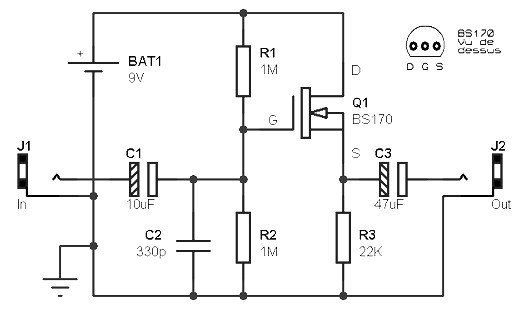

And arrange different circuits To be consistent with the needs of the amplifier.

We should learn or choose to create 4 preamplifier circuits in which each circuit uses only one transistor. In many cases, the amplifier needs different components such as gain, sensitivity, or even impedance matching. Therefore, we need to have a basic amplifier or preamplifier in order to amplify the signal to have enough power about 1.2Vp-p with low distortion.
#GUITAR PRE AMP FULL#
So, we have to enter the 1.2Vp-p input signal to hear 100 watts of full power.īut if we enter the lower sound signal like 0.1Vp-p., It will cause the sound to be lowered into the speaker as well. And the gain of about 22 times the input sensitivity or the input signal level of 1.2V. Imagine we have a 100 watts RMS amplifier. If you have this in your pedal board, chances are that some of your boxes become unnecessary and can be taken out.Related Posts Why use preamplifier circuit ? What is this, really? It's something like having an A/B box, and several compression, distortion and EQ pedals rolled into one enclosure. For an example of a guitar pre-amp in a pedal format, look at, for instance, the ADA APP-1: a new item from a re-start of the same company that brought us the ADA MP-1 rackmount MIDI-controlled tube preamp in the late 1980's. Whereas a distortion pedal might have just a simple tone control and a switch for bypass, a preamp pedal might have a switch between two channels, and a more sophisticated EQ, and perhaps even a delay effect built in.īasically it's just a more functionally integrated unit than regular pedals. Guitar pre-amps have features like switching between multiple channels that have independent settings, and integrate a lot more controls. "guitar preamp" is a kind of marketing word which refers to an electronic device that provides a more or less complete solution for taking the signal from a guitar and preparing a tone-shaped signal that is ready to go into a power-amp. When people tell you that they have a pre-amp in their pedalboard or that you should get one, they probably mean "guitar preamp". This setup is very similar to going through the clean channel of a guitar amplifier.
#GUITAR PRE AMP PATCH#
You should be able to plug into the box, from that patch into the power amp, and play with reasonably good sound.
#GUITAR PRE AMP PLUS#
So for instance if all you have is a guitar, amp and a 10 band equalizer stomp-box, plus a pair of cables, you have a preamp. They meet any reasonable definition of the word preamp. Even the ones that do not provide a level boost still boost the signal's current driving ability: the devices can drive a lower impedance load (such as a line level input) than your guitar is able to.

En equalizer pedal is a preamp.Īll of these boxes are designed such that any of them can be the first element in your signal chain right after the instrument, dealing with the weak signal from a passive pickup. A lot of multi-FX pedals accept instrument-level inputs, but output at line-level.Įvery pedal in your pedalboard already incorporates a preamp, or can be regarded as one. You may have a pre-amp already, and not know it. Other preamps are intended to colour the sound and add their own character. Some are designed to amplify the sound as accurately as possible. You also encounter preamps in the world of HiFi, where they are used to bring the signal from a turntable up to the level required by the main amp.ĭifferent preamps have different design goals.

Additionally a preamp can be an effective way of overdriving an amp, where the instrument alone wouldn't have enough power. But some amplifiers need line level input to get any kind of useful sound. Some guitar amps contain their own preamp, or at least are capable of sounding good with an instrument level input. This level is chosen because it's quiet enough to be produced by small electronic components, but loud enough to drown out interference noise for short distances. This is powerful enough that if you connected it direct to headphones, you'd generally hear a loud, clear sound. It's what's meant when you see "line in" or "line out" on sockets on audio equipment. "Line level" - a standard signal strength for sending unbalanced signals between audio components. It is literally the amount of energy generated by a vibrating string near a magnet. This is generally so weak that if you connected it direct to some headphones, you wouldn't hear anything. "Instrument level" - the signal strength that typically comes out of a pickup instrument. A pre-amp amplifies a quiet signal such as that from a passive guitar pickup, or a microphone, into a louder signal suitable for the input of a power amplifier.


 0 kommentar(er)
0 kommentar(er)
